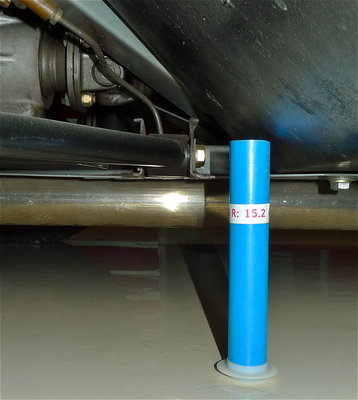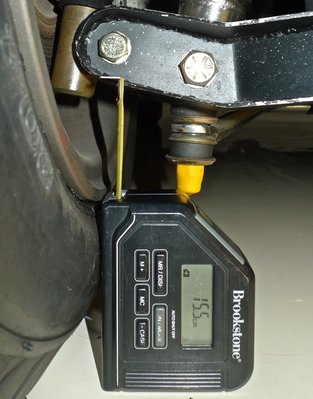Ride height
46 posts
• Page 3 of 4 • 1, 2, 3, 4
Having adjusted the rear spring platforms recently and this problem developing, I today measured the sill heights after some weeks of spirited driving and see the rear height has settled to 5 3/4 ", which is probably contributary to the problem. I've bumped it up today, unloaded, to 6 1/4" at the rear and found I only ground once on my bumpy testing circuit!. I've bought some new exhaust brackets and will fabricate a support at the front of the silencer if still grinding.
Graeme
S4 SE
S2 GTS
Caterham 420R
Sold - Peterson JPS Exige
S4 SE
S2 GTS
Caterham 420R
Sold - Peterson JPS Exige
-

661 - Coveted Fifth Gear

- Posts: 1275
- Joined: 29 Mar 2012
I will post two photos I took yesterday, using ride-height guides I fashioned many years ago.
The manual says block the suspension at 6.125" front (15.5cm) and 6.00" rear (15.2cm) ?beneath the front lower wishbone fulcrum and beneath each rear chassis leg adjacent to the wishbone pivot and NOT touching the
pivot.?
I am assuming that ?beneath front lower wishbone fulcrum? means the bottom edge of the lower front wishbone. Do you agree?
Andy
PS: Those are TTR wishbones, which are optimized for a lower ride height. I am wondering if I should shift to standard wishbones now.
The manual says block the suspension at 6.125" front (15.5cm) and 6.00" rear (15.2cm) ?beneath the front lower wishbone fulcrum and beneath each rear chassis leg adjacent to the wishbone pivot and NOT touching the
pivot.?
I am assuming that ?beneath front lower wishbone fulcrum? means the bottom edge of the lower front wishbone. Do you agree?
Andy
PS: Those are TTR wishbones, which are optimized for a lower ride height. I am wondering if I should shift to standard wishbones now.
Last edited by abstamaria on Wed Aug 08, 2012 2:45 pm, edited 1 time in total.
- abstamaria
- Fourth Gear

- Posts: 637
- Joined: 12 Nov 2010
Here is the rear arm.
I am assuming too that ?beneath each rear chassis leg adjacent to the wishbone pivot and NOT touching the pivot? is the lower chassis flange. Do you agree?
By the way, the chassis flange is the same height off the floor as the rear sill corners, so 6? (about 5.2mm) from the rear sill should be correct. I wonder though whether the front sill corners correspond to the 15.5mm at the fulcrum.
Andy
I am assuming too that ?beneath each rear chassis leg adjacent to the wishbone pivot and NOT touching the pivot? is the lower chassis flange. Do you agree?
By the way, the chassis flange is the same height off the floor as the rear sill corners, so 6? (about 5.2mm) from the rear sill should be correct. I wonder though whether the front sill corners correspond to the 15.5mm at the fulcrum.
Andy
- abstamaria
- Fourth Gear

- Posts: 637
- Joined: 12 Nov 2010
All of the Lotus height measurements are based on the standard tyres to set the ride height. What was standard becomes the question when. 520 x 13, 145 x 13, 155 x 13 were all used during the life of the Elan.
I would set height to what works for your usage and then check the all the wheel alignment parameters versus specifications at the height you select.
cheers
Rohan
I would set height to what works for your usage and then check the all the wheel alignment parameters versus specifications at the height you select.
cheers
Rohan
-

rgh0 - Coveted Fifth Gear

- Posts: 8829
- Joined: 22 Sep 2003
You're right, Rohan.
I figure the diameter for a 145R15 tire is 56.2cm and for a 155SR13 58cm, an 1.8cm difference.
I have 450M CR65 Dunlop racing tires on. Their specified diameter is 56cm, so I'm going to use the manual's specifications to start - or perhaps 1.0cm lower.
Best,
Andy
I figure the diameter for a 145R15 tire is 56.2cm and for a 155SR13 58cm, an 1.8cm difference.
I have 450M CR65 Dunlop racing tires on. Their specified diameter is 56cm, so I'm going to use the manual's specifications to start - or perhaps 1.0cm lower.
Best,
Andy
- abstamaria
- Fourth Gear

- Posts: 637
- Joined: 12 Nov 2010
Yes, I'd like to do that, Erik. I'll borrow corner weight scales again as soon as I sort the ride height and recheck alighnment.
Here I am am, checking ride height this morning with my supervisor.
Andy
Here I am am, checking ride height this morning with my supervisor.
Andy
- abstamaria
- Fourth Gear

- Posts: 637
- Joined: 12 Nov 2010
Considering that the ride height, as Rohan has confirmed, is based on the tyre diameter, I wonder if anyone has measured and documented the difference between the inner and outer suspension arm pivots or other reference points. In other words, the angle of the suspension arm rather than the ride height is what needs to be defined to ensure correct suspension geometry. This has the benefit of remaining constant for various diameter tyres. Anyone have that data? 
Mechanical Engineer, happily retired!
'67 S3 SE FHC
See Facebook page: W J Barry Photography
Put your money where your mouse is, click on "Support LotusElan.net" below.
'67 S3 SE FHC
See Facebook page: W J Barry Photography
Put your money where your mouse is, click on "Support LotusElan.net" below.
-

Galwaylotus - Coveted Fifth Gear

- Posts: 1348
- Joined: 01 May 2006
Perhaps, suspension arms parallel with the ground. Works for me, and you can dispense with the tape/rule and fit what ever tyre you like.
Colin.
Colin.
Galwaylotus wrote:Considering that the ride height, as Rohan has confirmed, is based on the tyre diameter, I wonder if anyone has measured and documented the difference between the inner and outer suspension arm pivots or other reference points. In other words, the angle of the suspension arm rather than the ride height is what needs to be defined to ensure correct suspension geometry. This has the benefit of remaining constant for various diameter tyres. Anyone have that data?
'68 S4 DHC
- fatboyoz
- Fourth Gear

- Posts: 693
- Joined: 04 Oct 2003
Yes, I agree. Parallel arms have been the standard and a good rule. The problem is that I have "26R" arms, which have a crook in them (see earlier photo). After I turned 60, the look and stance of a standard Elan have become more appealing to me, so I want to go back to that to the extent I can. I also can't fit 155s on current wheels, which are 6" wide, and of course the old wheels will not fit on 26R hubs.
I may have to switch to standard arms or flop the 26R items. I'll ask Tony Thompson.
Cheers,
Andy
I may have to switch to standard arms or flop the 26R items. I'll ask Tony Thompson.
Cheers,
Andy
- abstamaria
- Fourth Gear

- Posts: 637
- Joined: 12 Nov 2010
Thanks, guys. That's what I expected. As regards crooked arms, I would think a line between the inner and outer pivot axes is what should be parallel to the floor. It really doesn't matter what the arm does in between the points. 
Mechanical Engineer, happily retired!
'67 S3 SE FHC
See Facebook page: W J Barry Photography
Put your money where your mouse is, click on "Support LotusElan.net" below.
'67 S3 SE FHC
See Facebook page: W J Barry Photography
Put your money where your mouse is, click on "Support LotusElan.net" below.
-

Galwaylotus - Coveted Fifth Gear

- Posts: 1348
- Joined: 01 May 2006
Yes, that's the line I have been using as my reference, Galwaylotus. I just wonder now whether the relatively lower damper mounting bolt will restrict damper travel. I'll use the Elan first and see.
I reviewed my journal and found a handwritten note with drawings from Tony Thompson, describing how to set ride height for the lowered A-arms. At the front, he suggests setting the long section of the lower wishbone parallel to the ground. Since the wishbone then bends up to meet the trunnion, that would keep the damper at the same height relative to the chassis, but effectively lowers the chassis.
He ends by saying "if it looks right, it is right!" That was in the late 1990s.
Andy.
I reviewed my journal and found a handwritten note with drawings from Tony Thompson, describing how to set ride height for the lowered A-arms. At the front, he suggests setting the long section of the lower wishbone parallel to the ground. Since the wishbone then bends up to meet the trunnion, that would keep the damper at the same height relative to the chassis, but effectively lowers the chassis.
He ends by saying "if it looks right, it is right!" That was in the late 1990s.
Andy.
- abstamaria
- Fourth Gear

- Posts: 637
- Joined: 12 Nov 2010
To recap, the manual says block the suspension at 6.125" front (15.5cm) ?beneath the front lower wishbone fulcrum.? I?m not sure if that means that 15.5cm would be the ride height or that the car should settle to a lower ride-height after the blocks are removed.
On the assumption that the standard wishbone arms are straight and that the desired wishbone angle is parallel to the ground, wouldn?t the trunnion bolt then establish the right height for the inboard wishbone bolt? If so, that should be true regardless of tire profile height.
I measured the middle of the trunnion bolt on my car, and it is about 17.1cm from the ground to the center of the center of the bolt. If I took the measurement at the bottom of the wishbone, beneath the trunnion, as shown in the photo, the measurement is 15.5cm.
I wonder if ?beneath the front lower wishbone fulcrum? means the bottom of the wishbone at the inboard end?
Surprisingly, my trunnion bolt heights are not identical left to right. I wonder why that is.
Andy
On the assumption that the standard wishbone arms are straight and that the desired wishbone angle is parallel to the ground, wouldn?t the trunnion bolt then establish the right height for the inboard wishbone bolt? If so, that should be true regardless of tire profile height.
I measured the middle of the trunnion bolt on my car, and it is about 17.1cm from the ground to the center of the center of the bolt. If I took the measurement at the bottom of the wishbone, beneath the trunnion, as shown in the photo, the measurement is 15.5cm.
I wonder if ?beneath the front lower wishbone fulcrum? means the bottom of the wishbone at the inboard end?
Surprisingly, my trunnion bolt heights are not identical left to right. I wonder why that is.
Andy
- abstamaria
- Fourth Gear

- Posts: 637
- Joined: 12 Nov 2010
abstamaria wrote: I wonder if ?beneath the front lower wishbone fulcrum? means the bottom of the wishbone at the inboard end?
Andy
Andy,
That is how I interpreted it when I set mine. i.e. "Fulcrum: the support about which a lever pivots"
Cheers - Richard
- ardee_selby
- Coveted Fifth Gear

- Posts: 2197
- Joined: 30 Sep 2003
Thanks, Richard. "Fulcrum" technically could be the threaded peg or stud on which the lower wishbone rotated, but I suppose one coudn't put a block beneath that. Confusingly, the manual uses "pivot" instead of "fulcrum" when referring to the rear ride height. I'll start with 0.5cm lower all around.
Andy
Andy
- abstamaria
- Fourth Gear

- Posts: 637
- Joined: 12 Nov 2010
46 posts
• Page 3 of 4 • 1, 2, 3, 4
Total Online:
Users browsing this forum: No registered users and 28 guests



